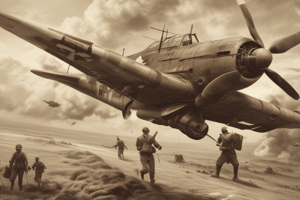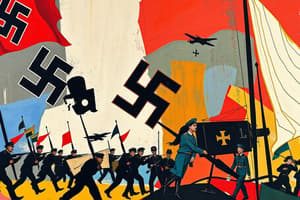Podcast
Questions and Answers
Which event during World War II led to the establishment of the United Nations?
Which event during World War II led to the establishment of the United Nations?
- The defeat of the Nazi regime
- The Yalta Conference
- The dropping of the atomic bombs (correct)
- The Potsdam Conference
Which group faced a process of denazification after World War II?
Which group faced a process of denazification after World War II?
- The Soviet Union
- Germany (correct)
- France
- Great Britain
What was one of the deep consequences of World War II on Europe's map?
What was one of the deep consequences of World War II on Europe's map?
- Germany remained undivided
- France gained territory
- Soviet Union's borders remained unchanged
- Poland lost land (correct)
Which wartime event terrified the general population all over the world?
Which wartime event terrified the general population all over the world?
What was the main purpose of the Yalta Conference during World War II?
What was the main purpose of the Yalta Conference during World War II?
Flashcards are hidden until you start studying
Study Notes
World War II
- The war was fought between two sides: the Axis Powers (Germany, Italy, and Japan) and the Allied Powers (Great Britain, France, Poland, and later the USSR and the US).
- The war started on September 1, 1939, when Germany invaded Poland, prompting Great Britain and France to declare war on Germany.
- The Nazi-Soviet Pact, signed by Germany and the USSR, ensured that they would not attack each other and would divide up Poland.
Axis Offensive (1939-1941)
- Germany used innovative Blitzkrieg (Lightning war) tactics to achieve early victories, subduing Europe to the Nazis.
- Italy attacked the British in Africa.
Allied Victories (1942-1945)
- Germany attacked the USSR in 1941, while Japan attacked the US at Pearl Harbor.
- The Germans lost the Battle of Stalingrad (1942-1943), and the Red Army started to push back the Nazis.
- The Allies defeated the Germans in Africa (Battle of El Alamein) and the Japanese (Battle of Midway).
- Germany was attacked from three sides: the East (Soviet counterattack), Italy (Invasion of Sicily, 1943), and France (Normandy Landings, 1944).
End of the War
- Hitler committed suicide on April 30, 1945, and the Soviets conquered Berlin on May 2, 1945.
- Germany surrendered on May 7, 1945.
- Japan refused to surrender, leading to the US dropping atomic bombs on Hiroshima and Nagasaki on August 6 and 9, 1945, respectively.
- Japan surrendered on September 2, 1945.
The Holocaust
- The Nazis and their European collaborators systematically killed 6 million Jews in extermination camps (Auschwitz, Treblinka) during the war.
- Other groups targeted included political opponents, homosexuals, people with disabilities, and Roma people.
Consequences of World War II
- The war resulted in the deaths of approximately 60 million people, with more than half being civilians.
- The Soviet Union lost about 10 million people.
- The war had devastating economic consequences, with large areas of Europe being completely destroyed and survivors facing a difficult reconstruction.
- The war led to significant political changes, with the defeated regimes being dismantled and Germany undergoing denazification.
- The US and the Soviet Union emerged as the new superpowers, dividing the world into two spheres and marking the beginning of the Cold War.
- The war resulted in significant territorial changes, with the map of Europe being dramatically altered.
- The defeated powers lost land in favor of Poland and the Soviet Union, and Germany was divided into four zones of occupation.
- The war had a profound emotional impact, with the dropping of atomic bombs and the Holocaust terrifying the general population and putting into question Western principles.
- The Allied leaders discussed peace in several conferences, including the Yalta Conference, the Potsdam Conference, and the San Francisco Conference, which established the United Nations and the Universal Declaration of Human Rights (1948).
Studying That Suits You
Use AI to generate personalized quizzes and flashcards to suit your learning preferences.




